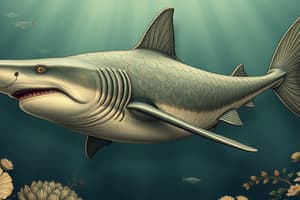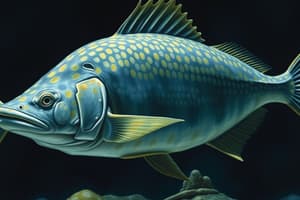Podcast
Questions and Answers
Give examples of organisms in the class Agnatha.
Give examples of organisms in the class Agnatha.
Lampreys and hagfish.
Give examples of organisms that are jawless.
Give examples of organisms that are jawless.
Lampreys and hagfish.
Give examples of organisms in the Chondrichthyes class.
Give examples of organisms in the Chondrichthyes class.
Sharks, skates, and rays.
List several characteristics of the class Chondrichthyes.
List several characteristics of the class Chondrichthyes.
List the common characteristics of the phylum chordate.
List the common characteristics of the phylum chordate.
List the common characteristics of bony fish.
List the common characteristics of bony fish.
What does fusiform mean in terms of body shape?
What does fusiform mean in terms of body shape?
What does depressiform mean in terms of body shape?
What does depressiform mean in terms of body shape?
What does globular mean in terms of body shape?
What does globular mean in terms of body shape?
Describe the superior mouth position.
Describe the superior mouth position.
Describe the terminal mouth position.
Describe the terminal mouth position.
Describe the inferior mouth position.
Describe the inferior mouth position.
Describe ganoid scales.
Describe ganoid scales.
Describe ctenoid scales.
Describe ctenoid scales.
Describe cycloid scales.
Describe cycloid scales.
What does dioecious mean?
What does dioecious mean?
What is the difference between synchronous fish and sequential fish?
What is the difference between synchronous fish and sequential fish?
How do fish maintain the proper amount of solutes in the body?
How do fish maintain the proper amount of solutes in the body?
The most common form of reproduction in fish is called?
The most common form of reproduction in fish is called?
Give examples of fish that are hermaphroditic.
Give examples of fish that are hermaphroditic.
What type of scales do sharks and rays have?
What type of scales do sharks and rays have?
What do sharks store to help control their water loss?
What do sharks store to help control their water loss?
How do sharks sense the prey in their surroundings?
How do sharks sense the prey in their surroundings?
What is the main form of reproduction for sharks?
What is the main form of reproduction for sharks?
What is the main form of reproduction in a Dogfish shark?
What is the main form of reproduction in a Dogfish shark?
What are 4 characteristics sharks/rays use for energy efficiency?
What are 4 characteristics sharks/rays use for energy efficiency?
List three ways sharks are different from bony fish.
List three ways sharks are different from bony fish.
What is the function of the liver in a shark?
What is the function of the liver in a shark?
What is the function of the spiral valve in a shark?
What is the function of the spiral valve in a shark?
Flashcards
Class Agnatha
Class Agnatha
Includes jawless organisms like lampreys and hagfish.
Class Chondrichthyes
Class Chondrichthyes
Comprises jawed fish such as sharks, skates, and rays.
Notochord Development
Notochord Development
Notochord becomes the vertebral column.
Nerve Chord
Nerve Chord
Signup and view all the flashcards
Swim Bladder
Swim Bladder
Signup and view all the flashcards
Fusiform
Fusiform
Signup and view all the flashcards
Depressiform
Depressiform
Signup and view all the flashcards
Globular
Globular
Signup and view all the flashcards
Superior Mouth
Superior Mouth
Signup and view all the flashcards
Terminal Mouth
Terminal Mouth
Signup and view all the flashcards
Inferior Mouth
Inferior Mouth
Signup and view all the flashcards
Ganoid Scales
Ganoid Scales
Signup and view all the flashcards
Ctenoid Scales
Ctenoid Scales
Signup and view all the flashcards
Dioecious
Dioecious
Signup and view all the flashcards
Synchronous Fish
Synchronous Fish
Signup and view all the flashcards
Sequential Hermaphroditism
Sequential Hermaphroditism
Signup and view all the flashcards
Osmoregulation
Osmoregulation
Signup and view all the flashcards
Oviparity
Oviparity
Signup and view all the flashcards
Protogyny
Protogyny
Signup and view all the flashcards
Protandry
Protandry
Signup and view all the flashcards
Denticles
Denticles
Signup and view all the flashcards
Urea Storage (Sharks)
Urea Storage (Sharks)
Signup and view all the flashcards
Lateral Lines/Sensory Pores
Lateral Lines/Sensory Pores
Signup and view all the flashcards
Ovoviviparous
Ovoviviparous
Signup and view all the flashcards
Dogfish Shark Reproduction
Dogfish Shark Reproduction
Signup and view all the flashcards
Backward-pointing Scales
Backward-pointing Scales
Signup and view all the flashcards
Shark vs. Bony Fish: Buoyancy
Shark vs. Bony Fish: Buoyancy
Signup and view all the flashcards
Shark Liver Function
Shark Liver Function
Signup and view all the flashcards
Spiral Valve Function
Spiral Valve Function
Signup and view all the flashcards
Study Notes
Class Agnatha
- Includes jawless organisms: lampreys and hagfish.
Class Chondrichthyes
- Comprises jawed fish: sharks, skates, and rays.
- Characteristics: lack swim bladder, possess a cartilaginous skeleton.
Phylum Chordata
- Key features:
- Notochord develops into the vertebral column.
- Nerve chord forms the brain and spinal cord before birth.
- Pharyngeal slits present.
- Postanal tail exists.
Bony Fish Characteristics
- Possess a swim bladder for buoyancy.
- Have bony scales covering their bodies.
- Maintain neutral buoyancy naturally.
- Reproduction primarily external and sexual.
Body Shapes of Fish
- Fusiform: typical streamlined shape.
- Depressiform: flattened structure.
- Globular: round morphology.
Mouth Position Types
- Superior: used for top feeding (e.g., surface feeders).
- Terminal: suited for predatory behavior (e.g., hunting).
- Inferior: designed for bottom feeding (e.g., scavenging).
Types of Fish Scales
- Ganoid: thick and heavy scales.
- Ctenoid: lighter, provides flexibility.
- Cycloid: similar to ctenoid, light and flexible.
Reproductive Terms
- Dioecious: refers to separate sexes in a species.
- Synchronous fish: functional gonads of both sexes present simultaneously.
- Sequential fish: ability to change sex over time (e.g., snook).
Osmoregulation
- Mechanism fish use to maintain solute balance in their bodies.
Reproductive Forms
- Oviparity: common reproductive method involving external fertilization (eggs and sperm).
- Hermaphroditic examples:
- Protogyny: female to male transition (e.g., wrasses).
- Protandry: male to female transition (e.g., anemonefish).
Scales of Sharks and Rays
- Denticles: small, backward-pointing scales providing texture.
Water Control in Sharks
- Sharks store urea to help manage water loss in saline environments.
Prey Detection
- Sharks have lateral lines and sensory pores to sense prey in their surroundings.
Reproductive Strategy in Sharks
- Ovoviviparous: eggs hatch internally, leading to live births.
Dogfish Shark Reproduction
- Follows ovoviviparous method with yolk sac nourishment during gestation, leading to live births.
Energy Efficiency in Sharks/Rays
- Use of backward-pointing scales to trap water, minimizing friction.
- Maintaining saltwater balance as elasmobranchs.
- Storing urea and other chemicals for buoyancy.
- Efficient dental structure aids predation.
Key Differences: Sharks vs. Bony Fish
- Sharks lack swim bladders; bony fish possess oily swim bladders.
- Sharks have cartilaginous skeletons; bony fish have bony skeletons.
- Sharks control water levels using urea; bony fish use different mechanisms.
Shark Organ Functions
- Liver: contains oil, aiding buoyancy by reducing body density.
- Spiral valve: increases intestinal surface area for enhanced nutrient absorption.
Studying That Suits You
Use AI to generate personalized quizzes and flashcards to suit your learning preferences.




